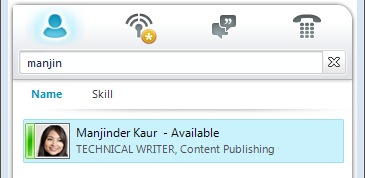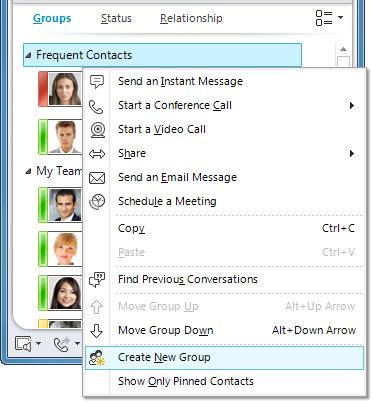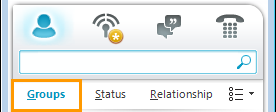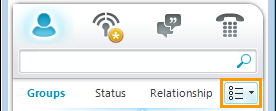Manage your contacts and Contacts list
There are several actions you need to do to keep your Contacts list current. This article helps you organize your contacts so that you can easily find the people who you need to get in touch with.
What do you want to do?
Search for people
The search box is located in the Contacts list, under the Contacts icon, and in the Phone view, under the Phone icon. You can search for the names of people or for a skill (job title), and then add them to your Contacts list, for example.

-
In the search box, type a name, email alias, or phone number. You can even type the name of a distribution group or alias. Microsoft Lync 2010 communications software displays the results as you type. If more than one contact or group comes up, the one who is in your Contacts list will appear at the top of the list. All contacts and non-contacts will have a vertical status bar to the left of the person's picture, and will indicate presence, such as Available, Offline, and Busy.
-
If your company uses Microsoft SharePoint services, Name and Skill buttons appear below the search box. You can search by using a keyword, such as job title or area of expertise. Click Skill to see others with similar areas of expertise or job titles. Click the X in the search box to return to the Contacts list.
Add a contact
The previous topic indicates that you can search for a person by using a name, email alias, or a phone number. For this procedure, we will use as an example, a search by name. So, after you've completed your search, a list of people whose names match the search is displayed. On the person's contact card, you can use either the Add to Contacts List selection or the Add button.
-
Scroll through the search returns list until you come to the person whom you want to add to your Contacts list. On the person's contact card, right-click, and then click Add to Contacts List. Or, click the down arrow on the Add button.
-
If you've set up groups or categories of contacts, a list of those groups is displayed. Select a contact group in which to place the contact.
-
If you haven't set up any groups but would like to, click Add to New Group, and then type the name of the new group that you want to create.
Tip: Type the person's full name (or most of it) in the search box, because if you type only a first name, especially a commonly used name, you'll get several returns. If your company has configured a limit on the number of people displayed, you'll then need to refine and re-do your search if the contact you want wasn't listed.
The default maximum number of contacts that can be added is 1000. Your actual number is set by your support team, so contact them for information if that number has not been made available to you.
Top of Page
Select multiple contacts
Sometimes it is more efficient to select several contacts at a time. An example would be when you're putting together a meeting invitation.
-
To select several non-adjacent contacts, press and hold the CTRL key while you click them.
-
For adjacent contacts, press and hold the SHIFT key while you click, or use the arrow keys to select.
Add people from outside your company to your Contacts list
Lync 2010 can display presence information for contacts who use email services such as the Windows Live network of Internet services (including MSN and Hotmail), AOL®, and Yahoo!®, and who are joined to Lync. Federated users (users who are outside your company) can do activities such as share presence information, make Lync calls, and conduct video conferences.
-
Open Lync, and, in the search box, type the email address for the person that you want to add to your Contacts list.
-
In the contact card that appears, click the Add button.
-
Select a contact group in which to place the contact. Also, you can create a new group at this time by typing the name beside the New Group field.
Some users have an email account with a service that is not federated with Lync. Although you can add these users to your Contacts list in the same way you add federated users, you won't see presence information for them.
Other users sign in to a federated site by using their non-federated user ID (email address). If this is the case, use the format user(unfederated.com)@federatedcompany.com--for example, MrContoso(gmail.com)@msn.com.--when you add the contact. Using this format will ensure that his or her presence will display in Lync.
Create a new group
When you've found the contacts that you want, you can add them to a contact group so you can find them easily next time. Lync automatically populates Frequent Contacts based on the 10 contacts with whom you most often have conversations. You can also "pin" your most important contacts to the top of the group for quick access. Lync pre-populates the pinned list with your team members.
Pin or unpin a frequent contact to the top of a group
To pin or unpin a frequent contact, do one of the following.
-
Open Lync, and, in your Contacts list, right-click the person, and then click Pin to Frequent Contacts.
-
To unpin a contact, right-click, and then click Unpin from Frequent Contacts.
Create a contact group
When you create a group in Lync, it's called a contact group because it organizes your contacts in groups that are meaningful to you. You can IM them, email them, and set up meetings with them.
You might have heard of Office 365 Groups. An Office 365 Group is a shared workspace for email, conversations, files, and calendar events where group members can collaborate and quickly get stuff done. You can't create an Office 365 Group from Lync. See Find help about groups in Office 365 for more information.
-
Open Lync, and, in your Contacts list, right-click any group name (for example, Frequent Contacts), click Create New Group, and then name the group.

-
To add people to the new group, search for a contact, point to the contacts name in the search results, and then click the plus sign (+). Or, right-click the contact in the search results, click Add to Contacts List, and then click the group name.
Note: When you create your first contact group Lync also automatically creates a group for you called Other Contacts. You can assign to this group new contacts who don't require more specific group memberships.
Delete or remove a group
To delete a group that you've created:
-
Select Groups from the display area above your Contacts list. (If that selection isn't displayed, click the down arrow directly below the Search field to display the Groups, Status, and Relationship buttons.)
-
Right-click the name of the group you want to delete, then select Delete Group from the drop-down menu.
Note: The Frequent Contacts and Other Contacts groups are automatically generated and therefore cannot be deleted.
Rename a group
To rename a group:
-
Right-click the group name on the Contacts list, select Rename Group, and then type the new group name.
Sort and display your contacts
You can sort your contacts according to various categories (their status, group membership, and privacy relationships), and you can choose how you want to display the individual contact listings.
Sort contacts in the Contacts list
-
To organize your contacts so that those who are online display at top of the list, click Status. Your online contacts will display at the top, followed by those with a status of Away, Unknown, and Unavailable.
-
To display your contacts according the groups they are members of (including the default groups Frequent Contacts and Other Contacts and any groups you've created), click Groups.

-
To sort your contacts by their privacy relationship, click Relationship. (To see explanations of what the relationships are, right-click a contact, and then point to Change Privacy Relationship.)
Change the look of individual entries in your Contacts list
-
Click the arrow next to the Display Options button below the search box to display the Layout Options menu.

Depending on how you've sorted your contacts, different options appear in the menu. For example, you can choose to show "friendly names" as opposed to email names or status details as opposed to only names. If your company has enabled displaying contact pictures in the Contacts list, you can choose whether to show pictures, which determines how many contacts fit in the window. (If you don't show pictures, the choice is between name only, on one line, or name and details, on a second line.)
Note: You can also turn off pictures everywhere in Lync by clicking My Picture in the Lync - Options dialog box. For more information, see Set picture options.
Change the way that Lync displays contacts
-
In your Contacts list, click the Display Options button below the search box to switch between one and two lines of information per contact. If your company uses contact photographs, a two-line view displays the photos.
-
For more choices, click the down arrow beside Display Options to open the Layout Options menu.
View contacts by privacy relationship (formerly called access level)
-
In your Contacts list, click the Relationship button below the search box.
To understand what presence information is exposed for each privacy relationship, see Control access to your presence information.
Move, copy, and remove contacts
In your Contacts list, do the following to move, copy, and remove or delete contacts.
-
To move a contact to another group, right-click the contact, point to Move Contact To, and then click the group you want.
-
To copy the contact to another group, right-click the contact, click Copy Contact to, and then click the group you want.
-
To remove the contact from the group, right-click the contact, and then click Remove from Group.
-
To remove the contact entirely, right-click the contact, and then click Remove from Contacts List.
Important: When you remove a contact from one group, that contact will be removed from your Contact List entirely unless he or she still has membership in another of your groups.
Important: Depending on how you are viewing contacts (by group, status, or relationship), moving and copying functions differ. Be aware that dragging contacts between privacy relationship groups changes the privacy relationship for the contact.
Note: Your Contacts list can't be exported to or copied by other Lync users. Every person's Contacts list will be different because everyone has unique relationships, privacy requirements, and communication preferences. A simple way to share key professional contacts with coworkers is to create a key-contacts distribution list in Outlook from which everyone can select contacts to add to their Contacts lists in Lync.
View a contact card
Depending on the privacy relationship that a contact has granted you, you can see his or her schedule, as well as a personal note. The contact card also provides a point for connecting with the contact, including starting an instant messaging conversation, calling, scheduling a meeting, or sending an email.
-
In your Contacts list, point to a contact's picture (or status icon, if pictures aren't displayed) to see a basic contact card.
-
To get more information, click the Expand contact card button (down arrow) in the lower-right corner of the card.

-
To keep the card visible, click the Pin button in the upper-right corner of the card. You can drag the card to a convenient place on the desktop.
Tag a contact
You can mark, or "tag," a contact in your Contacts list so that you'll be notified when he or she becomes available. Lync displays a notification as soon as a contact's status changes to Available.
-
In your Contacts list, right-click the person you want to tag.
-
Click Tag for Status Change Alerts.
Block a contact
To block individual contacts so they can't contact you using Lync, do the following:
-
Right-click the contact in the Contacts list, and then click Change Privacy Relationship.
-
Click Blocked Contact.
No comments:
Post a Comment